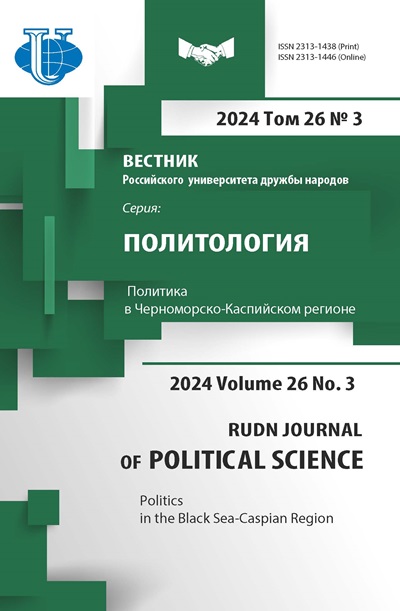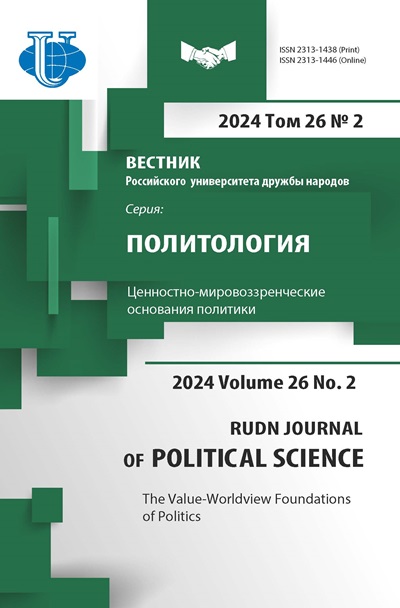The Dynamics of the «Threat to National Security» Pattern in the Russian Federation President Vladimir Putin’s Rhetoric in the Context of Public Mood of Russians
- Authors: Savenkov R.V.1,2, Travyankina A.K.2
-
Affiliations:
- Voronezh State University of Engineering Technologies
- Voronezh State University
- Issue: Vol 26, No 2 (2024): The Value-Worldview Foundations of Politics
- Pages: 436-447
- Section: VALUES IN COMMUNICATION PROCESSES: SEMANTIC AND TECHNOLOGICAL ASPECTS
- URL: https://journals.rudn.ru/political-science/article/view/39765
- DOI: https://doi.org/10.22363/2313-1438-2024-26-2-436-447
- EDN: https://elibrary.ru/LPDLOG
Cite item
Full Text
Abstract
The pattern reveals the way of thinking of the national leader and transmits a certain semantic code to the audience. One of the patterns that has been repeated over the years in the rhetoric of Russian President Vladimir Putin is the pattern of the existence of a “threat to national security.” The purpose of the paper is to analyze the content of the “threat to national security” pattern in the President Putin’s rhetoric, his relationship with the public sentiments of Russians and the role of the pattern in the Russian political system. The following methods were used: rhetorical analysis (identification of rhetorical techniques and strategies as means of effective communication and persuasion); conceptological analysis (analysis of linguistic means that objectify the concept, the basis of which is the pattern); correlation analysis (establishing the nature of the relationship between variables, used in the analysis of public opinion polls, correlating them with the propensity to support Putin). The empirical basis of the study consisted of eight texts of Vladimir Putin’s speeches in the period 2000-2022, analysis of the results of public opinion polls by WCIOM, Department of Sociology and Psychology of Politics, Faculty of Political Science, Moscow State University. The selection of texts was carried out on the basis of the presence in the speech (presidential periods only) of the most complete presented pattern of “threats to national security”, as well as on the basis of observing a chronological step between texts of an average of 3 years, in order to be able to conduct research in dynamics. As a result, it was established: 1. The existence of a threat to national security is a recurring theme in Vladimir Putin’s discourse throughout all terms of his presidency. 2. The pattern of “threats to national security” has undergone changes from a threat of an internal nature to a predominantly external one. 3. The significance of the threat in the discourse increases every year. 4. A persistent feature of Russian public sentiment is the need for security. An analysis of Putin’s place in the political and communication space of Russia allows us to designate him as an actor-network person, whose political discourse is the most accessible source of isolating value codes capable of consolidating Russian society, which until 2022 is in a state of anomie, a value mismatch between different levels of existing political values. The scientific novelty of this work lies in the fact that Putin’s rhetoric has not previously been analyzed from the standpoint of identifying in it the pattern of “threat to national security” and its political-semiotic significance, relationship with trends in changes in the public mood of Russians, despite a number of works devoted to the formation the image of the enemy, affective rhetoric, the “us/them” dichotomy and the problematic level of the language code, which are essentially partial manifestations of this pattern.
Keywords
About the authors
Roman V. Savenkov
Voronezh State University of Engineering Technologies; Voronezh State University
Email: rvsav@yandex.ru
ORCID iD: 0000-0002-1643-2444
Doctor of Political Sciences, Associate Professor, Professor of the Department of Philosophy and History, Voronezh State University of Engineering Technologies, Associate Professor, Department of Sociology and Political Science, Voronezh State University
Voronezh, Russian FederationAnna K. Travyankina
Voronezh State University
Author for correspondence.
Email: travyankina_anna@mail.ru
ORCID iD: 0009-0002-8757-8659
Postgraduate Student of History Department
Voronezh, Russian FederationReferences
- Borisov, O.S. (2012). Cognitive processes in sociocultural dimension. Scientific notes of Petrozavodsk State University, 3(124), 83–89. (In Russian).
- Castells, M. (2016). Communication Power. Moscow: Publishing house of the Higher School of Economics. (In Russian). [Castells, M. (2009). Communication Power. Oxford, New York: Oxford University Press].
- Dijk, T.A. van. (1999). Discourse Analysis of News. In Jensen K.B. (Ed.), A Handbook of Qualitative Methodologies for Mass Media Research, 5, 353–371.
- Feezell, J.T. (2018). Agenda setting through social media: The importance of incidental news exposure and social filtering in the digital era. Political Research Quaterly, 71(2), 482–494.
- Freelon, D.G. (2010). Analyzing online political discussion using three models of democratic communication. New Media & Society, 20(10), 1–19. http://doi.org/10.1177/1461444809357927
- From, Yeltsin to Putin: Three eras in the historical consciousness of Russians. (2007). Moscow: WCIOM. (In Russian).
- Gaman-Golutvina, O.V., & Smorgunov, L.V. (2023). The political in a turbulent world space. Polis. Political Studies, 1, 7–10. (In Russian). http://doi.org/10.17976/jpps/2023.01.02
- Grigoryeva, E.B. (2013). The influence of the authoritarian syndrome on the process of legitimation of government institutions in today’s Russia. RUDN Journal of Political Science, 3, 13–26. (In Russian).
- Hammond, M. (2017). What is an online community? A new definition based around commitment, connection, reciprocity, interaction, agency, and consequences. International Journal of Web Based Communities, 13(1), 118–136. http://doi.org/10.1504/IJWBC.2017.082717
- Kerr, M. (2015). Scream: Chilling Adventures in the Science of Fear. PublicAffairs.
- Latour, B. (2017). On actor-network theory. A few clarifications, plus more than a few complications. Logos, 173–200. (In Russian). [Latour, B. (1996). On actor-network theory. A few clarifications. Soziale Welt, 47(4), 369–381].
- Leonov, I.V. (2011). Evolution of the term “pattern” in cultural knowledge: From concept to scientific category. Current Issues of Modern Science, 20, 41–48. (In Russian).
- Lisova, S.Y. (2009). Political Rhetoric: linguistic patterns. Law and Politics, 6, 1318–1323. (In Russian).
- Mochalova, K.P. (2012). Myth-making in the political process of modern Russia. Acmeology, 2, 126–129. (In Russian).
- Selezneva, A.V. (2016). Russian society in the post-Soviet period: Dynamics of value changes of the elite and citizens. Political science (RU), Special issue, 149–169. (In Russian).
- Shestopal, E.B. (2015). Putin 3.0: Society and power in the modern history of Russia. Monograph. Moscow: Argamak-media (In Russian).
- Shestopal, E.B. (2023). Paradoxes of political leadership. Polis. Political Studies, 3, 181–191. (In Russian). http://doi.org/10.17976/jpps/2023.03.13
- Shevchenko, Y.A. (2002). Discourse analysis of political media texts. Polis. Political Studies, 6, 18–23. (In Russian).
- Shomova, S.A. (2016). From mystery to street art. Essays on cultural archetypes in political communication. Moscow: Publishing house of the Higher School of Economics. (In Russian).
- Tsuladze, A.M. (2003). Political mythology. Moscow: Eksmo. (In Russian). Williams, K.C. (2012). Fear Appeal Theory. California State University, Stanislaus.
















